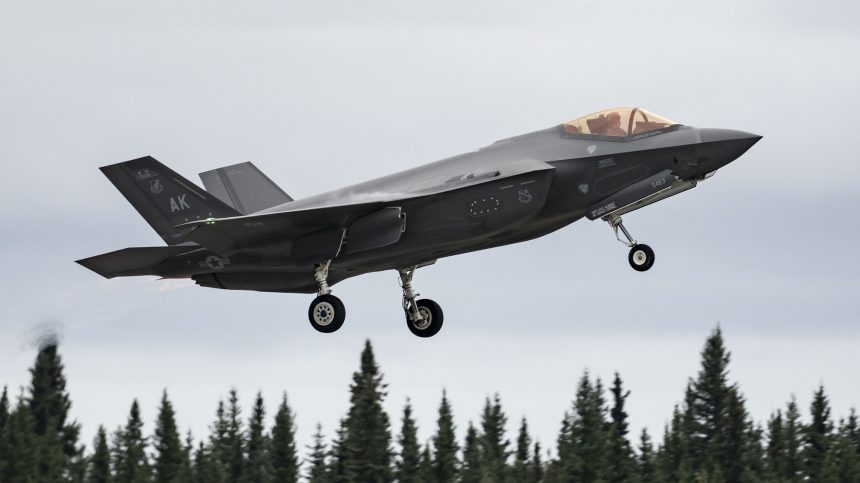PACAF’s investigation found water-contaminated hydraulic fluid froze and caused a landing gear malfunction, leading to the loss of an F-35A at Eielson AFB.
An Accident Investigation Board (AIB) report released on Aug. 26, 2025, by the U.S. Pacific Air Forces (PACAF) has shed light on the circumstances that led to the loss of a U.S. Air Force F-35A Lightning II during a training mission at Eielson Air Force Base, Alaska, on Jan. 28, 2025. As we reported back then, the jet crashed within the fence line of the base, with a video showing the F-35 spinning towards the ground with its landing gear extended.
The aircraft, assigned to the 355th Fighter Squadron of the 354th Fighter Wing, was destroyed after a failed recovery attempt, though the pilot safely ejected with only minor injuries. According to the press release about the investigation, the total loss was estimated at $196.5 million.
According to the official AIB report, the mishap was triggered by hydraulic fluid contaminated with water, which froze in the frigid Alaskan temperatures and prevented the proper extension of the landing gear. This malfunction set off a chain of events that ultimately rendered the aircraft uncontrollable, leading to the crash.
Takeoff and Initial Malfunction
The accident occurred shortly before 1 p.m. local time, during a routine training sortie. After takeoff, the pilot attempted to retract the landing gear, but the nose landing gear (NLG) failed to align and remained canted between 17 and 25 degrees to the left. This irregularity was quickly diagnosed as a malfunction, and the pilot entered a holding pattern while troubleshooting the problem with the assistance of the Supervisor of Flying (SOF) and Lockheed Martin engineers which were contacted by phone.
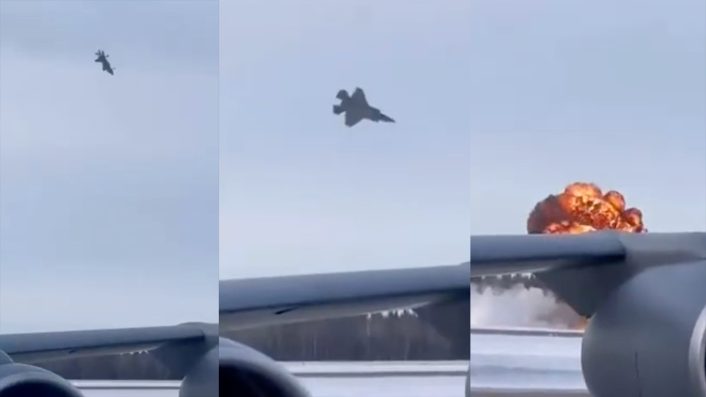
At the time, temperatures at Eielson were well below freezing- with the observed temperature being −17 °C (1.4 °F) – and the aircraft had already spent considerable time exposed to the cold during pre-flight checks. These conditions played a central role in the failure, as the AIB later determined.
Attempts to Recenter the Landing Gear
To correct the issue, the pilot was advised to perform touch-and-go maneuvers, in an effort to help realign landing gear. On the first attempt, the nose gear failed to recenter. A second attempt, flown at higher speed, partially improved the situation, reducing the cant angle to around 6 degrees.
However, ice buildup inside the main landing gear struts prevented them from fully extending. As a result, the aircraft’s Weight-on-Wheels (WoW) sensors falsely registered that the jet was on the ground, even though it was airborne. This sensor error caused the flight control system to switch to the “on ground” flight control law, severely disrupting the jet’s handling.
The pilot suddenly experienced uncommanded yaw and pitch oscillations. With the aircraft rapidly becoming uncontrollable, assuming an attitude with 30-40 degrees pitch up and a 38 degrees left roll at just 372 feet above ground level and a speed of 222 knots, the pilot initiated the ejection. The escape system worked as designed, and the pilot landed safely nearby.
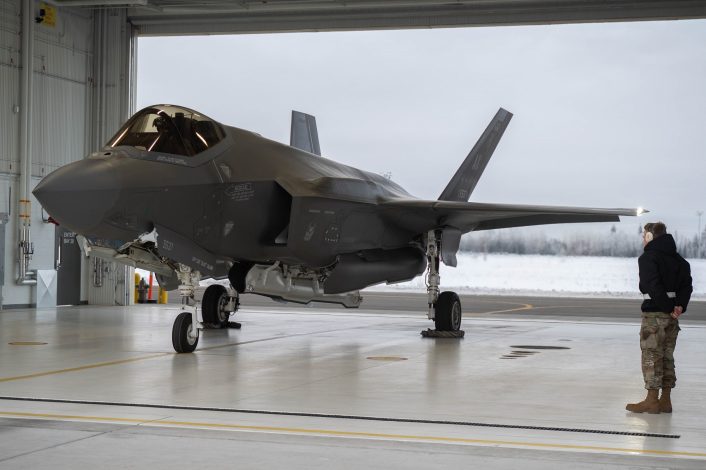
Aircraft Loss and Immediate Response
Moments after ejection, the F-35A stalled at an altitude of 2,665 feet AGL, spiraled out of control and impacted the ground with a 116-degree right bank within the perimeter of Eielson Air Force Base, thus being destroyed by the crash and subsequent fire. Emergency responders were on scene within one minute, reports the AIB.
No injuries to base personnel or civilians were reported, although the mishap represented a major material loss. The destroyed aircraft, serial number 19-5535, was valued at $196.5 million, says the service.
Root Cause Analysis
The AIB determined that the root cause of the crash was hydraulic fluid contaminated with water, which froze in the extreme cold and prevented the landing gear from fully extending. Because the landing gear could not properly seat into position, the system transmitted false signals to the aircraft’s Weight on Wheel sensors, leading to the erroneous ground mode activation.
The investigation traced the contamination back to maintenance and hazardous materials (HAZMAT) management shortcomings, especially insufficient manning and frequent supervision changes. According to the report, hydraulic servicing at Eielson was carried out with improper procedures.
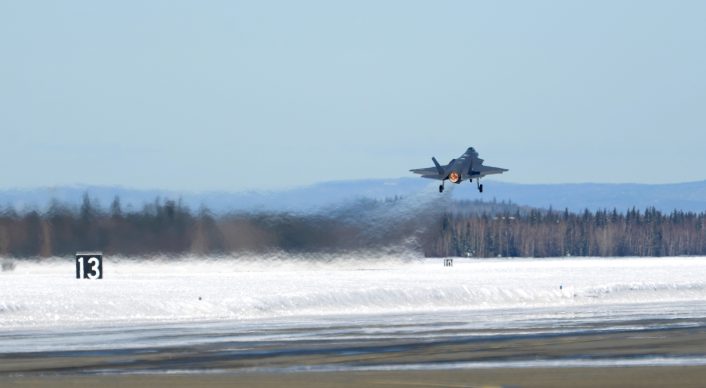
Maintenance personnel used less fluid than required due to equipment limitations, as a hand cart was employed instead of a nitrogen servicing cart, and the lines were not adequately flushed. This left water contamination inside the system, as the AIB determined water was already in the struts prior to the servicing conducted three days before the mishap.
Furthermore, barrels of hydraulic fluid were not properly stored or tracked, and insufficient staffing and supervision contributed to the problem. The AIB highlighted that these failures created an environment where water infiltration into hydraulic systems could go undetected.
Decision-Making and Human Factors
While the technical malfunction was the direct cause of the mishap, the AIB also noted contributing human factors. Specifically, the decision to continue airborne troubleshooting with successive touch-and-go maneuvers was called into question, although the AIB highly praised the efforts by all parties involved.
However, the board found that the persistence in attempting to mechanically recenter the landing gear, rather than preparing for an emergency landing with the gear misaligned, increased the likelihood of catastrophic failure. In fact, the report mentions that a Lockheed Martin maintenance circular from April 2024, stating that WoW sensor issues could lead to aircraft controllability issues, could have been potentially referenced, and the pilot could have been advised to conduct a planned full stop landing or a controlled ejection instead of a second touch-and-go.
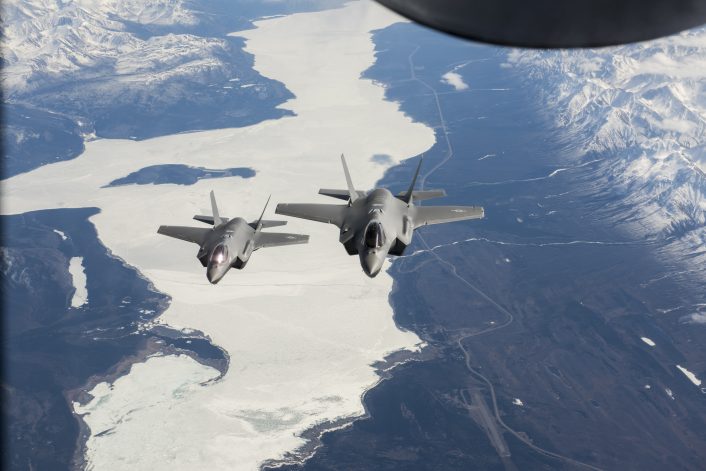
That said, the report emphasized that the pilot was a fully qualified and highly experienced F-35A evaluator pilot, with a total of over 2,700 flight hours, including 555 hours in the F-35A. The pilot also received a “Commendable” rating in the area of Flight Leadership and Instructor Performance for demonstrating exceptional skill and knowledge.
A Similar Incident
The Jan. 28 crash was not an isolated case. Just nine days later, on Feb. 6, another F-35A experienced a comparable nose gear malfunction, mentions the report. In that instance, the pilot received a nose wheel gear unsafe indication after takeoff, flying for approximately 40 minutes with the landing gear lowered before landing uneventfully.
The report indicated the unsafe nose gear indication was due to the uplock missing the roller and rotating the nose wheel 10 degrees to the left in a similar manner to the crashed aircraft. Additionally, while landing the nose wheel went from 10 degrees to the left to 5 degrees at touchdown.
Ground testing then confirmed that frozen hydraulic fluid contamination was again responsible. The report concluded that it was likely water was already present during previous flights, but no malfunctions happened as temperatures were higher and water did not have time to freeze before takeoff.

